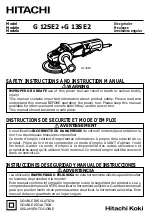
Page 4
RULES FOR SAFE OPERATION
Dust and waste materials should not be allowed
to build up in the workshop.
Hot metal sparks could
start a fire.
Do not enlarge or alter the center hole
of the grinding
wheel as this could result in breaking it.
Use only the normal grinder surface.
Never use the
side or upper surfaces for cutting.
Keep the tool and its handle dry, clean, and free
from oil and grease.
Always use a clean cloth when
cleaning. Never use brake fluids, gasoline, petroleum-
based products, or any strong solvents to clean your
tool.
Additional Rules for Safe Operation
Know your power tool.
Read operator's manual care-
fully. Learn its applications and limitations as well as
the specific potential hazards related to this tool. Fol-
lowing this rule will reduce the risk of electric shock, fire,
or serious injury.
Always wear safety glasses with side shields.
Ev-
eryday eyeglasses have only impact resistant lenses;
they are
NOT
safety glasses.
Protect your lungs.
Wear a face or dust mask if the
operation is dusty.
Protect your hearing.
Wear hearing protection during
extended periods of operation.
Inspect tool cords periodically
and if damaged, have
repaired at your nearest authorized service center. Stay
constantly aware of cord location.
Check damaged parts.
Before further use of the tool,
a guard or other part that is damaged should be
carefully checked to determine that it will operate
properly and perform its intended function. Check for
alignment of moving parts, binding of moving parts,
breakage of parts, mounting, and any other conditions
that may affect its operation. A guard or other part that
is damaged should be properly repaired or replaced by
an authorized service center.
Following this rule will
reduce the risk of electric shock, fire, or serious injury.
Do not abuse cord. Never carry tool by cord or yank
it to disconnect from receptacle. Keep cord from
heat, oil and sharp edges.
Following this rule will
reduce the risk of electric shock or fire.
Make sure your extension cord is in good condi-
tion.
When using an extension cord, be sure to use one
heavy enough to carry the current your product will
draw. A wire gage size (A.W.G.) of at least
16
is
recommended for an extension cord 100 feet or less in
length. A cord exceeding 100 feet is not recommended.
If in doubt, use the next heavier gage. The smaller the
gage number, the heavier the cord. An undersized cord
will cause a drop in line voltage resulting in loss of power
and overheating.
Use only accessories that are recommended by the
manufacturer for your model.
Accessories that may
be suitable for one tool, may become hazardous when
used on another tool.
Service
Tool service must be performed only by qualified
repair personnel.
Service or maintenance performed
by unqualified personnel could result in a risk of injury.
When servicing a tool, use only identical replace-
ment parts. Follow instructions in the Maintenance
section of this manual.
Use of unauthorized parts or
failure to follow Maintenance Instructions may create
a risk of electric shock or injury.
Specific Safety Rules for Grinders
Always use proper guard with grinding wheel.
A
guard protects operator from broken wheel fragments.
Accessories must be rated for at least the speed
recommended on the tool warning label.
Wheels
and other accessories running over rated speed can
fly apart and cause injury.
Hold tool by insulated gripping surfaces when per-
forming an operation where the tool may contact
hidden wiring or its own cord.
Contact with a “live”
wire will make exposed metal parts of the tool “live”
and shock the operator.
Grinding wheel and guard must be securely
attached
as described in this operating manual before
connecting the grinder to a power source.
Grinding wheels must be stored in a dry place.
Before attaching the grinding wheel,
inspect it for
visible defects. If cracked, chipped, or warped, do not
install it.
Do not overtighten the clamp nut
on the grinding
wheel. Excessive tightening can cause the wheel to
crack during operation
Make sure that the guard is in good condition
and
securely installed before operating grinder.
Do not clamp the grinder in a vise or use as a
fixed grinder.
Never turn on the grinder
with the grinding wheel
or any rotating parts touching the workpiece.
Use only grinding wheels in compliance
with ANSI
standard B7.1 and rated greater than 11,000 RPM.
Do not use the grinder if the disc flange or clamp
nut is missing
or if the spindle is bent.
Always hold the grinder securely with two hands
while working and at all times when it is running.
Never cover the air vents in the motor housing
with your hands while operating the grinder.
Hold the tool away from your body
while it is
running. Keep your hands away from the abrasive
attachments.
































